July 7 - 13, 2013: Issue 118
Aurora Australis 2013 – A Great Year for the Southern Lights
As we head into May in Australia a symphony of lights erupts around Antarctica and over Tasmania that was once, on this day in 1928 (7th of July) seen as far away as Sydney. The aurora australis, reputedly named by Captain Cook in 1773, has wonder years and paler years. This year, 2013, is a wonder year and alike that of 1928 or even 1859, due to a cycle of Solar Flares which some state is greater every 11th year while others lay claim to a 13 year cycle.
About every 11 to 13 years the sun's magnetic poles swap places and the sun shows high levels of activity. Large sunspots form, and there is an increase in coronal mass ejections (CMEs) - the gusts of energy that react with Earth's magnetic field to cause auroras. The period during which the sun reaches its peak in activity is known as solar maximum. This is set to occur in 2013.
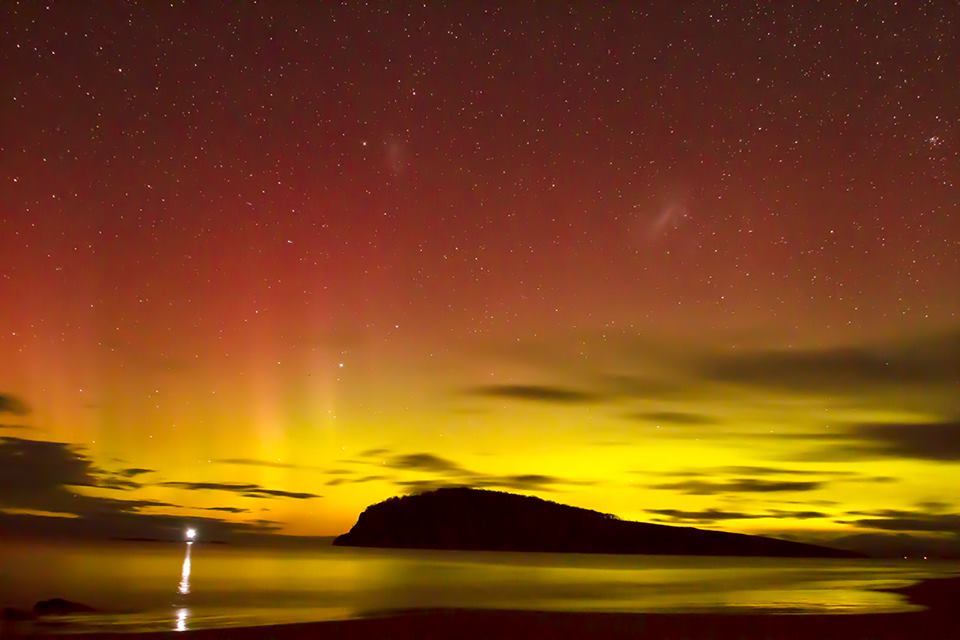
Photo by and courtesy of Luke Maher, taken at Clifton Beach, Tasmania 29-30.6.2013
Why Is This So??
First X-Class Solar Flares of 2013
May 14, 2013 — On May 13, 2013, the sun emitted an X2.8-class flare, peaking at 12:05 p.m. EDT. This is the strongest X-class flare of 2013 so far, surpassing in strength the X1.7-class flare that occurred 14 hours earlier. It is the 16th X-class flare of the current solar cycle and the third-largest flare of that cycle. The second-strongest was an X5.4 event on March 7, 2012. The strongest was an X6.9 on Aug. 9, 2011.
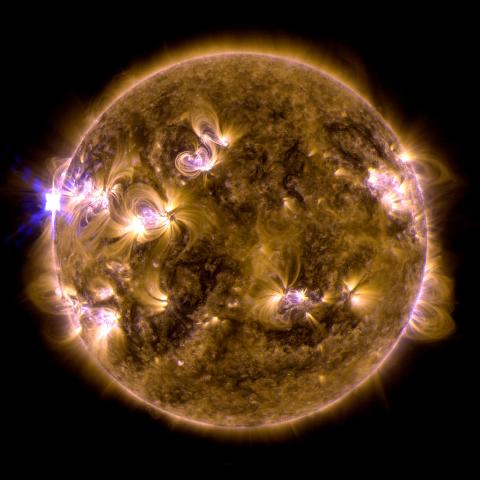 The X2.8-class flare was also associated with a coronal mass ejection, or CME, another solar phenomenon that can send billions of tons of solar particles into space, which can potentially affect electronic systems in satellites and on the ground. The CME was not Earth-directed, but could pass NASA's STEREO-B, Messenger and Spitzer spacecraft. Their mission operators have been notified. Experimental NASA research models show that the CME left the sun at 1,200 miles per second beginning at 12:18 p.m. EDT. If warranted, operators can put spacecraft into safe mode to protect the instruments from solar material.
The X2.8-class flare was also associated with a coronal mass ejection, or CME, another solar phenomenon that can send billions of tons of solar particles into space, which can potentially affect electronic systems in satellites and on the ground. The CME was not Earth-directed, but could pass NASA's STEREO-B, Messenger and Spitzer spacecraft. Their mission operators have been notified. Experimental NASA research models show that the CME left the sun at 1,200 miles per second beginning at 12:18 p.m. EDT. If warranted, operators can put spacecraft into safe mode to protect the instruments from solar material.
Solar flares are powerful bursts of radiation. Harmful radiation from a flare cannot pass through Earth's atmosphere to physically affect humans on the ground, however - when intense enough - they can disturb the atmosphere in the layer where GPS and communications signals travel. This disrupts the radio signals for as long as the flare is ongoing - the radio blackout associated with this flare has since subsided.
The Impacts of Solar Flares
Some people worry that a gigantic "killer solar flare" could hurl enough energy to destroy Earth, but this is not actually possible.
"X-class" denotes the most intense flares, while the number provides more information about its strength. An X2 is twice as intense as an X1, an X3 is three times as intense, etc.
This flare erupted from an active region just out of sight over the left side of the sun, a region that will soon rotate into view. This region has produced two smaller M-class flares as well.
The May 12 flare was also associated with a coronal mass ejection, another solar phenomenon that can send billions of tons of solar particles into space, which can affect electronic systems in satellites and on the ground. Experimental NASA research models show that the CME left the sun at 745 miles per second and is not Earth-directed, however its flank may pass by the STEREO-B and Spitzer spacecraft, and their mission operators have been notified. If warranted, operators can put spacecraft into safe mode to protect the instruments from solar material. There is some particle radiation associated with this event, which is what can concern operators of interplanetary spacecraft since the particles can trip computer electronics on board.
Increased numbers of flares are quite common at the moment because the sun's normal 11-year activity cycle is ramping up toward solar maximum, which is expected in 2013. Humans have tracked the solar cycle continuously since it was discovered in 1843, and it is normal for there to be many flares a day during the sun's peak activity. The first X-class flare of the current solar cycle occurred on Feb. 15, 2011, and there have been another 15 X-class flares since, including this one. The largest X-class flare in this cycle was an X6.9 on Aug. 9, 2011.
NOAA's Space Weather Prediction Center (http://swpc.noaa.gov) is the U.S. government's official source for space weather forecasts, alerts, watches and warnings. The sun erupted with an X1.7-class solar flare on May 12, 2013. This is a blend of two images of the flare from NASA's Solar Dynamics Observatory: One image shows light in the 171-angstrom wavelength, the other in 131 angstroms. (Credit: NASA/SDO/AIA)
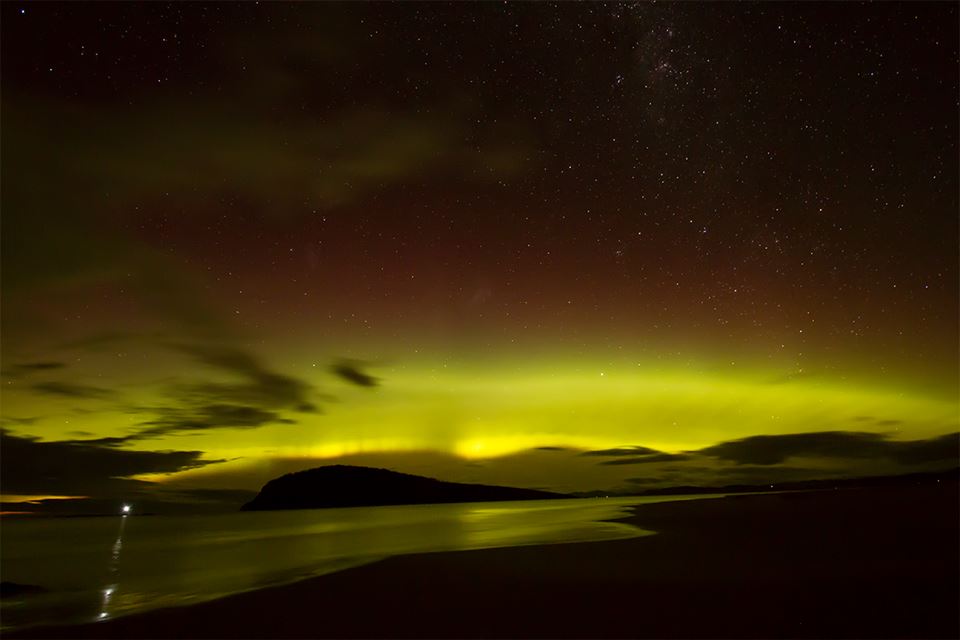
Photo by and courtesy of Luke Maher, taken at Clifton Beach, Tasmania 29-30.6.2013
An aurora (plural: aurorae or auroras; from the Latin word aurora, ‘sunrise’) is a natural light display in the sky particularly in the high latitude (Arctic and Antarctic) regions, caused by the collision of energetic charged particles with atoms in the high altitude atmosphere (thermosphere). The charged particles originate in the magnetosphere and solar wind and, on Earth, are directed by the Earth's magnetic field into the atmosphere. Most aurorae occur in a band known as the auroral zone, which is typically 3° to 6° in latitudinal extent and at all local times or longitudes. The auroral zone is typically 10° to 20° from the magnetic pole defined by the axis of the Earth's magnetic dipole. During a geomagnetic storm, the auroral zone expands to lower latitudes.
Aurorae are classified as diffuse or discrete. The diffuse aurora is a featureless glow in the sky that may not be visible to the naked eye, even on a dark night. It defines the extent of the auroral zone. The discrete aurorae are sharply defined features within the diffuse aurora that vary in brightness from just barely visible to the naked eye, to bright enough to read a newspaper by at night. Discrete aurorae are usually seen in only the night sky, because they are not as bright as the sunlit sky. Aurorae occasionally occur poleward of the auroral zone as diffuse patches or arcs (polar cap arcs), which are generally invisible to the naked eye.
Typically the aurora appears either as a diffuse glow or as "curtains" that approximately extend in the east-west direction. At some times, they form "quiet arcs"; at others ("active aurora"), they evolve and change constantly. Each curtain consists of many parallel rays, each lined up with the local direction of the magnetic field lines, suggesting that auroras are shaped by Earth's magnetic field. Indeed, satellites show that electrons are guided by magnetic field lines, spiraling around them while moving toward Earth.
The similarity to curtains is often enhanced by folds called "striations". When the field line guiding a bright auroral patch leads to a point directly above the observer, the aurora may appear as a "corona" of diverging rays, an effect of perspective.
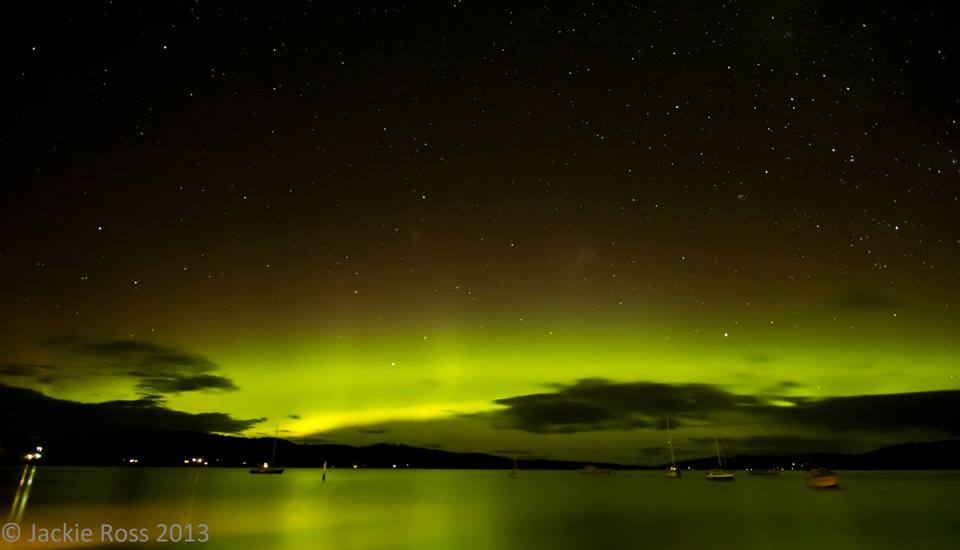
Photo by and courtesy of Jackie Ross, taken in Tinderbox, Tasmania, 29-30.6.2013. See www.facebook.com/jackierossphotography
Although it was first mentioned by Ancient Greek explorer and geographer Pytheas, Hiorter and Celsius first described in 1741 evidence for magnetic control, namely, large magnetic fluctuations occurred whenever the aurora was observed overhead. This indicates (it was later realized) that large electric currents were associated with the aurora, flowing in the region where auroral light originated. Kristian 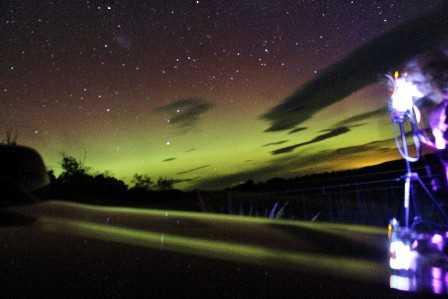 Birkeland(1908) deduced that the currents flowed in the east-west directions along the auroral arc, and such currents, flowing from the dayside toward (approximately) midnight were later named "auroral electrojets"
Birkeland(1908) deduced that the currents flowed in the east-west directions along the auroral arc, and such currents, flowing from the dayside toward (approximately) midnight were later named "auroral electrojets"
In northern latitudes, the effect is known as the aurora borealis (or the northern lights), named after the Roman goddess of dawn, Aurora, and the Greek name for the north wind, Boreas, by Pierre Gassendi in 1621. Auroras seen near the magnetic pole may be high overhead, but from farther away, they illuminate the northern horizon as a greenish glow or sometimes a faint red, as if the Sun were rising from an unusual direction. Discrete aurorae often display magnetic field lines or curtain-like structures, and can change within seconds or glow unchanging for hours, most often in fluorescent green. The aurora borealis most often occurs near the equinoctes. The northern lights have had a number of names throughout history. The Cree call this phenomenon the "Dance of the Spirits". In Medieval Europe, the auroras were commonly believed to be a sign from God.
Photo in text by and courtesy of Donna Gibbons, 10km north of Swansea on Saturday night, Tasmania, taken over dashboard of car, 29-30.6.2013. See: www.mydestination.com/Tasmania
The southern counterpart, the aurora australis (or the southern lights), has features that are almost identical to the aurora borealis and changes simultaneously with changes in the northern auroral zone. It is visible from high southern latitudes in Antarctica, South America, New Zealand, and Australia. Aurorae also occur on other planets. Auroras are more frequent and brighter during the intense phase of the solar cycle when coronal mass ejections increase the intensity of the solar wind. Auroras are occasionally seen in temperate latitudes, when a magnetic storm temporarily enlarges the auroral oval. Large magnetic storms are most common during the peak of the eleven-year sunspot cycle or during the three years after that peak.
The auroras that resulted from the "great geomagnetic storm" on both 28 August and 2 September 1859 are thought the most spectacular in recent recorded history. Balfour Stewart, in a paper to the Royal Society on 21 November 1861, described both auroral events as documented by a self-recording magnetograph at the Kew Observatory and established the connection between the 2 September 1859 auroral storm and the Carrington-Hodgson flare event when he observed that, "It is not impossible to suppose that in this case our luminary was taken in the act." The second auroral event, which occurred on 2 September 1859 as a result of the exceptionally intense Carrington-Hodgson white light solar flare on 1 September 1859, produced auroras so widespread and extraordinarily brilliant that they were seen and reported in published scientific measurements, ship logs, and newspapers throughout the United States, Europe, Japan, and Australia.
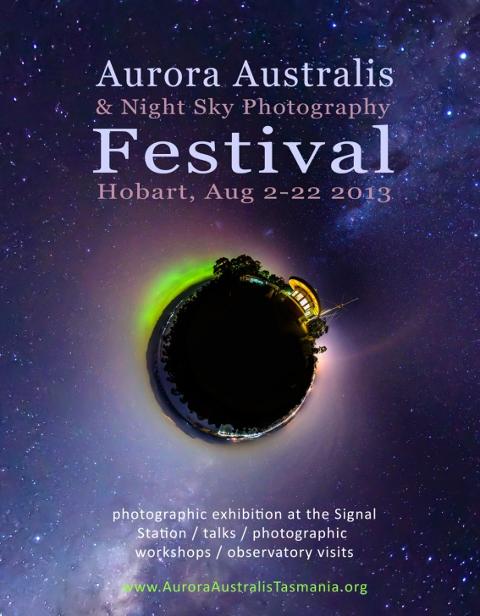 Richard Christopher Carrington (26 May 1826 – 27 November 1875) was an English amateur astronomer whose 1859 astronomical observations demonstrated the existence of solar flares as well as suggesting their electrical influence upon the Earth and its aurorae; and whose 1863 records of sunspot observations revealed the differential rotation of the Sun.
Richard Christopher Carrington (26 May 1826 – 27 November 1875) was an English amateur astronomer whose 1859 astronomical observations demonstrated the existence of solar flares as well as suggesting their electrical influence upon the Earth and its aurorae; and whose 1863 records of sunspot observations revealed the differential rotation of the Sun.
Folktales and travellers' tales say that the aurora can generate noise such as claps, crackles, and static sounds, usually faint and brief. For a long time scientists were dubious, since sound has been hard to document, and auroral displays themselves are too high in the sky for them to be heard on the ground. However, researchers from Aalto University in Finland published a study in 2012 saying that they recorded "clapping" sounds correlated to the visual presence of the aurora borealis, and that these sounds were produced approximately 230 feet (70 m) above ground. They suggested that these sounds come from the solar particles associated with creating the aurora. The University of Alaska notes that aurora noise is so rare that hearing it is a "once in a lifetime experience", possible only during times of maximum aurora activity, on windless nights away from other noise sources.
Aurora (astronomy). (2013, July 5). In Wikipedia, The Free Encyclopedia. Retrieved from http://en.wikipedia.org/w/index.php?title=Aurora_(astronomy)&oldid=562957949
Photographers of 2013, who have kindly allowed us to share their glorious capturing of this year’s Aurora Australis in the skies above Tasmania, have become such a passionate group, and their images so spectacular, that an exhibition of these is planned for August this year. If you're in Tasmania for this event, look up, August and September, historically, seem to be the months for seeing these wonderful lights. The Facebook Group - Aurora Australis Tasmania has lots of pointers on which equipment to use and how to get the best photos should you wish to record your own.
One last note: 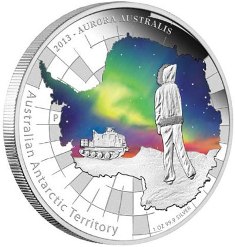 The Perth Mint has started accepting orders for their first ever "glow in the dark" silver coin. Released as part of the Australian Antarctic Territory series, the coin features a depiction of the Aurora Australis coloured with glow in the dark ink.
The Perth Mint has started accepting orders for their first ever "glow in the dark" silver coin. Released as part of the Australian Antarctic Territory series, the coin features a depiction of the Aurora Australis coloured with glow in the dark ink.
The coin is struck by The Perth Mint from 1oz of 99.9% pure silver in proof quality. The coin’s reverse depicts a snowfield with a tracked vehicle and a human observer beneath a coloured representation of the Aurora Australis, within the outline of Antarctica. As well as the inscription 2013 - AURORA AUSTRALIS, the reverse also includes the words ‘Australian Antarctic Territory’ and The Perth Mint’s traditional ‘P’ mintmark. To capture the stunning colours of the Aurora Australis, the representation of this natural wonder has been coloured with glow-in-the-dark ink. Issued as Australian legal tender, the coin’s obverse depicts the Ian Rank-Broadley effigy of Her Majesty Queen Elizabeth II, the year-date and the monetary denomination. The Perth Mint will release no more than 7,500 of these Australian Antarctic Territory Series – Aurora Australis 2013 1oz Silver Proof Coins.The coin is housed in a classic charcoal-coloured presentation case, which comes within a stylish outer shipper and is accompanied by a numbered Certificate of Authenticity.
Purchase at: http://www.perthmint.com.au/catalogue/australian-antarctic-territory-series-aurora-australis-2013-1oz-silver-proof-coin.aspx?affiliateID=16

Photo by and courtesy of Richard Youd, Communications Technical Officer, Australian Antarctic Division, Davis Station 2013, https://www.facebook.com/richard.youd
July 7th 1928 - Aurora Australis in Sydney !!!!!
SKY PHENOMENA.
The Artilleries of Heaven.
(BY IVY MOORE.)
 It was almost exactly six years ago, on July 8, 1928, that the "Sydney Morning Herald" published a most interesting account of the Aurora Australis, which had astonished and delighted Sydney dwellers the preceding night. Commencing at 8 pm., the-sky first of all glowed with a vivid, rosy light, as though illumined by the artilleries of heaven. Strange rays of intense brightness came and went; then a greenish blue luminous cloud appeared, contrasted against the rose-tinted sky. It was so strangely beautiful as to appear almost unearthly, and Mr. F. Gale, of the British Astronomical Association, said that such a phenomenon is very rarely to be seen in Sydney, only ten displays having been noted here during the last forty-six years, although farther south these magnetic storms are frequent, being connected with the activity of sun spots, which have a very large magnetic field of influence.
It was almost exactly six years ago, on July 8, 1928, that the "Sydney Morning Herald" published a most interesting account of the Aurora Australis, which had astonished and delighted Sydney dwellers the preceding night. Commencing at 8 pm., the-sky first of all glowed with a vivid, rosy light, as though illumined by the artilleries of heaven. Strange rays of intense brightness came and went; then a greenish blue luminous cloud appeared, contrasted against the rose-tinted sky. It was so strangely beautiful as to appear almost unearthly, and Mr. F. Gale, of the British Astronomical Association, said that such a phenomenon is very rarely to be seen in Sydney, only ten displays having been noted here during the last forty-six years, although farther south these magnetic storms are frequent, being connected with the activity of sun spots, which have a very large magnetic field of influence.
Many other very beautiful and curious sky effects can be seen by the keen observer, the student of nature, and, above all, by the early riser. Only a fortnight ago a most remarkable cloud formation was visible over Sydney Harbour at dawn. The basin of Middle Harbour was filled with dense white vapour, which flowed silently, but swiftly, like an opaque river of cloud, through the Spit channel, past Balmoral and Manly, across to North Head, winding its way out to the open ocean. The dark peaks of the hills were silhouetted above this ghostly aerial river, and behind them showed the delicate, rosy flush of dawn. A few stars still glimmered palely, as yet uneclipsed by the coming of the sun, and on the slopes of Quarantine was flung, as though by fairy fingers, a dainty bridal veil of frost. The eerie effect of this pageant was unforgettable, enacted as it was to a sleeping and heedless world.
The great French writer and poet, Francois Coppee, gives a very fine description of a marvellous sunset which he witnessed in Paris. The heavens glowed with fire and radiant colouring, but the passers-by hurried on, all indifferent to the loveliness before them, each one intent on his own trifling business.
A SEA OF COLOURED LIFE.
A strange effect was witnessed at Jervis Bay Naval Station some years ago. A very ardent sunset dyed the waters of the bay vermilion. Dark fragments of purple cloud, edged with glowing gold, floated on the horizon, and suddenly a great school of dolphins and porpoises entered the heads, all dipping and plunging through the crimson tide. The harbour seemed alive with strange sea beasts, rollicking from shore to shore, and magnified by the waning light into the semblance of pre-historic monsters. It was a weird scene, startled seagulls uttered mournful cries and fled to the safety of Bowen Island, where only a few snakes and a quaint colony of penguins were to be found to dispute their sway.
In North Africa from time to time there is flashed across the world at sunset a ray of green light of unearthly purity and beauty. It is seldom seen, and is, therefore, credited by the Arabs with being the sign of great happiness to come. As the sun disappears below the horizon, across the soft azure of the Mediterranean, there falls a hush. The gentle south breeze, laden with the perfume of musk, spices, and roses, syringa, and jasmin, drops, and is gone. Land and sea seem to wait in a haze of tender mist. Then, born of the ecstasy of the moment, the emerald glow flashes, scintillates, and is gone, leaving an exquisite memory to the darkening world.
In Switzerland the majestic Alps are responsible for the alpen glow's wonderful glamour. The sun has declined behind the great mountains, and a deep, rose red ray of glorious light is shed over the, valley, dyeing the snow-capped peaks a vivid shade. All appears unreal, as unearthly as the hidden fires of heaven, if glimpsed suddenly. Sounds cease, every one stands motionless, filled with admiration for this marvellous spectacle! Then, all in a moment, the light deepens, darkens, glows with almost unbearable intensity, fades, trembles, and dies away. It is dark immediately, and a silvery crescent moon peeps forth timidly in the green trans-lucent sky. The musical tinkle of cowbells from the slopes announces the approach of the homing cattle. The keen air is pungent with the scent of pines! From afar comes the thunder of an avalanche. The alpen glow has gone, leaving with us an ever beautiful memory to cherish. Night folds the land in a dark mantle, a shooting star flashes down like a gleaming rocket, the cold mountain breeze stirs the fir trees, and the stream rushes down the valley with glittering cascades and waterfalls. The land sleeps; the artilleries of heaven are quenched.
SKY PHENOMENA. (1934, July 7). The Sydney Morning Herald(NSW : 1842 - 1954), p. 11. Retrieved from http://nla.gov.au/nla.news-article17087668
Photo in text by and courtesy of Luke Maher, taken at Clifton Beach, Tasmania 29-30.6.2013
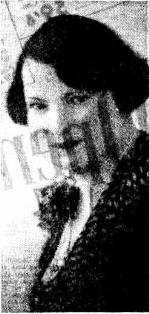 Ivy Moore birth name: Ivy Amy Mary Walshe Born: 24 Aug 1888 London ENGLAND ; Died: 1 Aug 1956 Mosman NEW SOUTH WALES Gender: Female. Arrived in Australia: 24 Aug 1924
Ivy Moore birth name: Ivy Amy Mary Walshe Born: 24 Aug 1888 London ENGLAND ; Died: 1 Aug 1956 Mosman NEW SOUTH WALES Gender: Female. Arrived in Australia: 24 Aug 1924
Ivy Amy Mary Moore was the daughter of George Varian Walshe, a clerk in the General Post Office, and Edith Marian Walshe nee Meux-Smith. Much of her early life was spent in France, Algeria and Corsica. Moore claimed to have travelled widely, living in Spain for seven years and visiting cathedral towns with her uncle, a well known English painter.
On 14 August 1913 she married John Irwin Moore, an Australian born Sub-Lieutenant in the Royal Navy. Their only child, Jim, was born in Gosport, England on 4 September 1916. She travelled to Australia in 1919 to be with her husband who was bringing HMS Swordsman to join the Royal Australian Navy. In 1920 they returned to England and came out again, arriving in Melbourne on 24 August 1924.
Moore's husband subsequently returned to England, leaving his wife and child with a small remittance. She wrote prolifically to support them - poetry, historical articles and journalistic pieces and was consistently published in the Sydney Morning Herald and Le Courier Australien.In 1936 Moore became 'travelling publicity officer' for Holyman Airways, forerunner to Australian National Airways and wrote numerous articles about air travel. In 1935 the French Ministry/Academy conferred on her its Academic Palms, as an Officier d'Academie for her literary services including the promotion of France and the French language. Moore also received the Free French Service Medal and was made a Member of Honor of the Free French Soldiers' Association. She was a founder and president of the Friends of France Association and an Honorary Citizen of Le Bresse.
Moore was known to Dame Mary Gilmore who published her 1937 work Australian violets: Author: Ivy Moore; Mary Gilmore Publisher: Sydney : Printed by Shipping Newspapers, [1937). She also wrote extensive articles for the Sydney Morning Herald and numerous poems were published throughout Australian newspapers.
(Source: Compiled from information supplied by the author's granddaughter, Trish Burgess)
Photo: APPOINTED LIBRARÍAN. Photo by Dorothy Welding. MRS. IVY MOORE, of Mosman, Who has been appointed librarian of the Alliance Française in Sydney. For her services in the French community in Sydney, Mrs. Moore has been decorated, with the Palmes Académique. APPOINTED LIBRARIAN. (1937, March 4). The Sydney Morning Herald (NSW : 1842 - 1954), p. 22. Retrieved from http://nla.gov.au/nla.news-article17349152
Pitt Water or Pittwater - Tasmania
Some of you may not be aware that there is a Pitt Water or Pittwater in Tasmania too, an estuary of the Coal River on the Sorrell peninsula around 20 kilometres from Hobart. It too is a beautiful place, one of the first areas settled in Tassie, and a home to many waterbirds. A lot of Tasmania looks very similar to Pittwater, Sydney and you will often find many former Tasmanians ‘flock’ here due to the place, and its people, reminding them of home!
Pitt Water or Pittwater - Tasmania
This wetland system provides habitat for migratory and resident birds and is an important estuarine ecosystem for marine life and commercial ventures such as oyster farming. A number of threatened birds, animals and plants including some unusual and unique species call this home.
These values were recognised internationally when the whole wetland was declared a Ramsar Site in 1994. It covers an area of 3 334 hectares and includes all of the Pitt Water and Orielton Lagoon. The Pitt Water Nature Reserve is a part of the Ramsar Site and covers an area of 776 hectares comprising five discrete areas: Orielton Lagoon, Barilla Bay, upper Pitt Water, Woody and Barren islands. From and See more at: http://www.parks.tas.gov.au/file.aspx?id=11639
ENTRANCE TO THE RIVER DERWENT, TASMANIA.
THE river Derwent, at the south end of Tasmania, is one of the finest and most accessible ports in the southern hemisphere. Vessels approaching it from the Southern Ocean enter between Tasman's Island or the Pillar on the east, and Tasman's Head, the most southerly point of South Bruni Island, on the we at, the distance between those two points being about sixty miles. After sailing northward twenty-five or thirty miles, the entrance to Storm Bay is passed through, which is twenty-three or twenty-four miles wide, from Cape "Raoul, the south point of Tasman's Peninsula, on the east, and Cape Frederick Henry, the south point of North Bruni Island, on the wea4-.Steering about N.N.E. the real mouth or entrance to the Derwent is reached, the width at that point being nearly five miles from Cape Direction on the east to the main land on the west. About one mile south of Cape Direction is a small rocky islet on which is erected what is known as the Iron Pot lighthouse. This is shown prominently in our illustration. The lighthouse is a square obelisk, built of freestone, and the light, which is a fixed one, is sixty-five feet above high water mark. On the left of the illustration is Cape Direction, behind which is Frederick Henry Bay, which leads to Pittwater, the estuary of the Coal River.
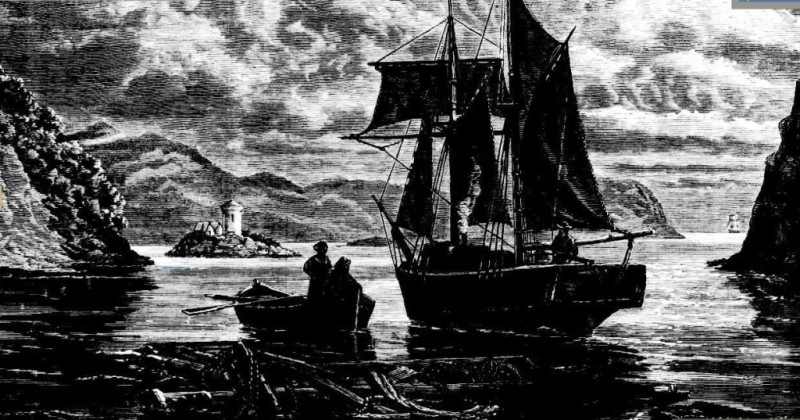
The high land in the background is a part of Tasman's Peninsula, the lofty peak of Mount Communication, 1131 feet high, having on its summit one of the stations for the semaphore by means of which messages used to be transmitted by semaphore between Hobart Town and the penal settlement at Port Arthur, on the Peninsula. The open ocean is visible in the distance with a vessel entering, while on the right hand is a portion of the rocky bluff of North Bruni Island. From the sea up to and beyond Hobart Town there is no bar or other impediment to navigation, while such is the depth of water at Hobart Town that vessels of the largest size can be moored to the spacious new wharf, and there is space enough to enable the greatest fleet to anchor in the port in perfect safety.
ENTRANCE TO THE RIVER DERWENT, TASMANIA. (1877, August 18). Illustrated Sydney News (NSW : 1853 - 1872), p. 11. Retrieved from http://nla.gov.au/nla.news-article63334467
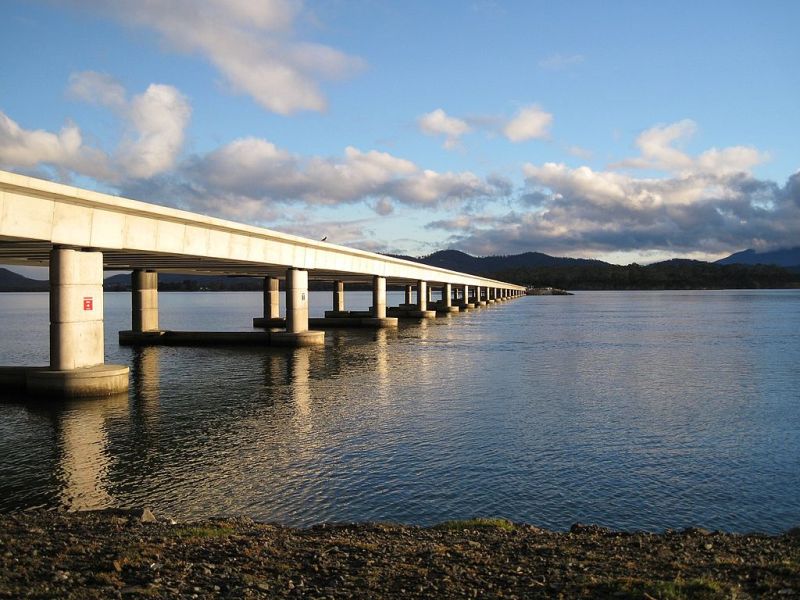
The McGees Bridge and causeway over Pitt Water, in Hobart, Tasmania, Australia. Photo taken 19 July 2008 Author Kham Tran - www.khamtran.com
Mcgees Bridge and causeway crosses Pitt Water within the greater area of Hobart, Tasmania. The bridge provides a vital link between Hobart and two of Tasmania's principal tourist attractions - Port Arthur Historic Site on the Tasman Peninsula and the picturesque East Coast via the Tasman Highway.